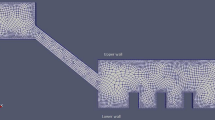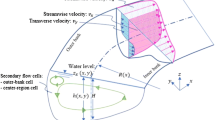Abstract
Modifications are proposed of two recently developed hybrid CFD strategies, Delayed Detached Eddy Simulation (DDES) and DDES with Improved wall-modeling capability (IDDES). The modifications are aimed at fine-tuning of these approaches to the k-ω SST background RANS model. The first one includes recalibrated empirical constants in the shielding function of the SA-based DDES model which are shown to be suboptimal (not providing the needed level of elimination of the Model Stress Depletion (MSD)) for the SST-based DDES model. For the SST-IDDES variant, in addition to that, a simplification of the original SA–based formulation is proposed, which does not cause any visible degradation of the model performance. Both modifications are extensively tested on a range of attached and separated flows (developed channel, backward-facing step, periodic hills, wall-mounted hump, and hydrofoil with trailing edge separation).
Similar content being viewed by others
References
Fröhlich, J., Von Terzi, D.: Hybrid RANS/LES methods for the simulation of turbulent flows. Prog. Aerosp. Sci. 44, 349–377 (2008)
Menter, F.R., Kuntz, M., Langtry, R.: Ten years of experience with the SST turbulence model. 4th International Symposium on Turbulence Heat and Mass Transfer, pp. 625–632 (2003)
Spalart, P.R., Deck, S., Shur, M.L., Squires, K.D., Strelets, M.K., Travin, A.: A new version of detached-eddy simulation, resistant to ambiguous grid densities. Theor. Comput. Fluid Dyn. 20, 181–195 (2006)
Shur, M.L., Spalart, P.R., Strelets, M.K., Travin, A.K.: A hybrid RANS-LES approach with delayed-DES and wall-modeled LES capabilities. Int. J. Heat Fluid Flow 29, 1638–1649 (2008)
ANSYS FLUENT 12.0 Theory Guide, ANSYS Inc. (2009)
Rhie, C.M., Chow, W.L.: Numerical study of the turbulent flow past an airfoil with trailing edge separation. AIAA J. 21, 1525–1532 (1983)
Dukowwicz, J.K., Dvinsky, A.S.: Approximate factorization as a high-order splitting for the implicit incompressible flow equations. J. Comput. Phys. 102, 336–347 (1992)
Armsfield, S., Street, R.: The fractional-step method for the Navier-Stokes equations on staggered grids: accuracy of three variations. J. Comput. Phys. 153, 660–665 (1999)
Spalart, P.R., Jou, W.H., Strelets, M., Allmaras, S.R.: Comments on the feaslibility of LES for wings, and on a hybrid RANS/LES approach. In: Proceedings of first AFOSR international conference on DND/LES (1997)
Vogel, J.C., Eaton, J.K.: Combined heat transfer and fluid dynamic measurements downstream of a backward-facing step. J. Heat Mass Transfer 107, 922–929 (1985)
Strelets, M.: Detached Eddy simulation of massively separated flows. AIAA J. 2001–0879, 1–18 (2001)
Reichardt, H.: Vollstandige darstellung der turbulenten geschwindigkeitsverteilung in glatten leitungen. Z. Angew. Math Mech. 31, 208–219 (1951)
Simpson, R.L., Long, C.H., Byun, G.: Study of vortical separation from an axisymmetric hill. Int. J. Heat Fluid Flow 23, 582–591 (2002)
Temmerman, L., Leschziner, M.A.: Large eddy simulation of separated ow in a streamwise periodic channel constriction. In: Int. Symp. Turb. Shear Flow Phenomena, Stockholm, Sweden (2001)
Breuer, M., Peller, N., Rapp, C., Manhart, M.: Flow over periodic hills—numerical and experimental study in a wide range of Reynolds numbers. Comput. Fluid 38, 433–457 (2009)
Greenblatt, D., Paschal, K.B., Chung-Sheng, Y., Harris, J.: A separation control CFD validation test case Part 2. Zero efflux oscillatory blowing. AIAA Pap. 2005–0485, 1–24 (2005)
Adamian, D., Travin, A.: An Efficient Generator of Synthetic Turbulence at RANS-LES Interface in Embedded LES of Wall-Bounded and Free Shear Flows. ICCFD6 (2010)
Avdis, A., Lardeau, S., Leschziner, M.: Large Eddy simulation of separated flow over a two-dimensional hump with and without control by means of a synthetic slot-jetle. Flow Turbul. Combust. 83, 343–370 (2009)
Rumsey, C.L., Gatski, T.B., Sellers, W.L., Vatsa, V.N., Viken, S.A.: Summary of the 2004 CFD Validation Workshop on Synthetic Jets and Turbulent Separation Control. AIAA Pap. 2004–2217, 1–31 (2004)
Blake, W.K.: A statistical description of pressure and velocity fields the trailing edge of a flat strut. David Taylor Naval Ship R & D Center Report 4241, Bethesda (1975)
Wang, M., Moin, P.: Dynamic wall modeling for large-eddy simulation of complex turbulent flows. Phys. Fluid 14, 2043–2051 (2002)
Wang, M., Moin, P.: Computation of trailing-edge flow and noise using Large-Eddy SimulationNo Title. AIAA J. 38, 2201–2209 (2000)
Author information
Authors and Affiliations
Corresponding author
Rights and permissions
About this article
Cite this article
Gritskevich, M.S., Garbaruk, A.V., Schütze, J. et al. Development of DDES and IDDES Formulations for the k-ω Shear Stress Transport Model. Flow Turbulence Combust 88, 431–449 (2012). https://doi.org/10.1007/s10494-011-9378-4
Received:
Accepted:
Published:
Issue Date:
DOI: https://doi.org/10.1007/s10494-011-9378-4




